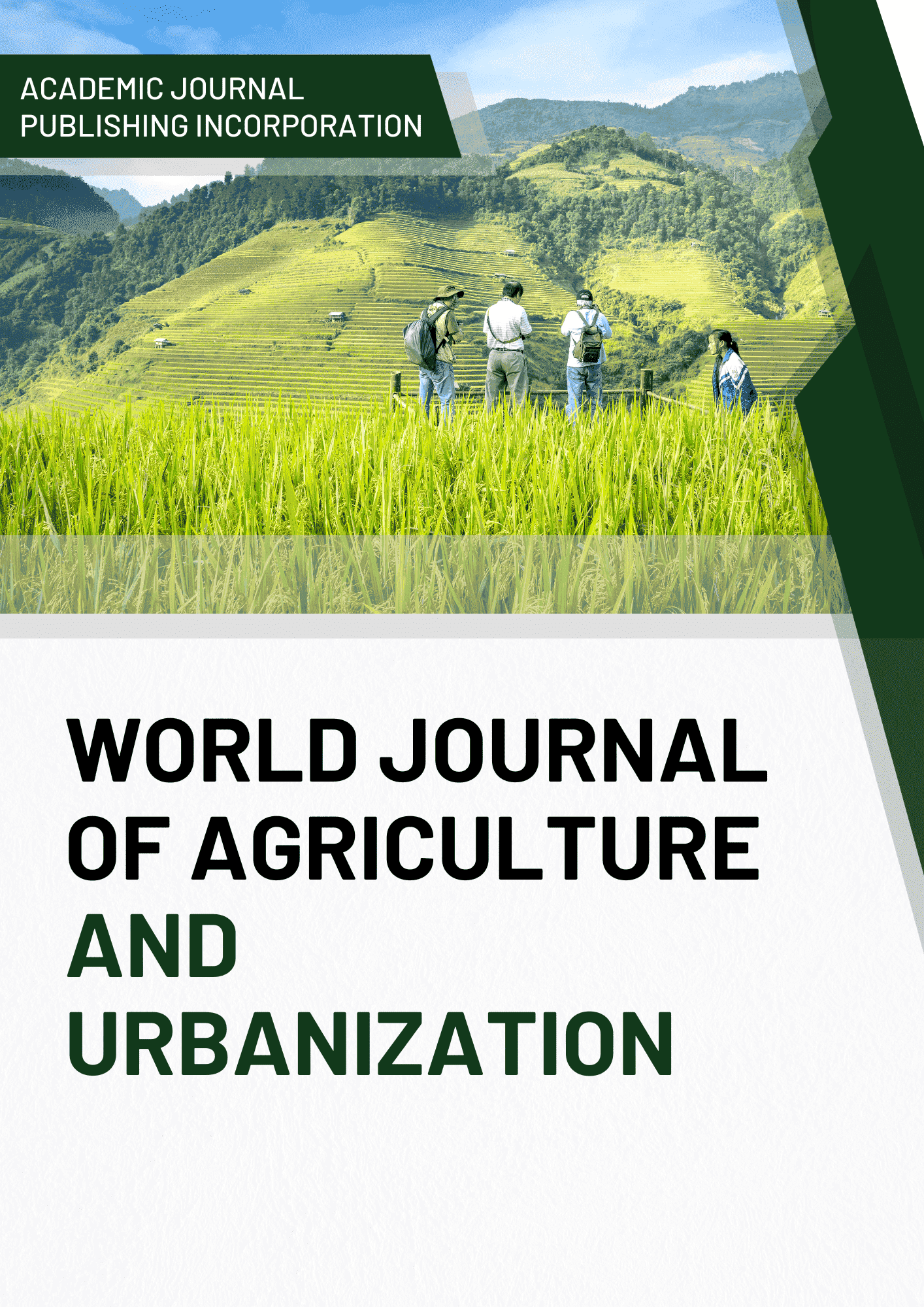Agricultural Economy of India
DOI:
https://doi.org/10.51699/wjau.v2i9.95Keywords:
rural, incomes, poor, food, security, population, crops, farmers, agricultureAbstract
Nearly three-quarters of India’s families depend on rural incomes.
The majority of India’s poor (some 770 million people or about 70 percent) are found in rural areas.
India’s food security depends on producing cereal crops, as well as increasing its production of fruits, vegetables and milk to meet the demands of a growing population with rising incomes.
References
Bureau, The Hindu (17 March 2023). "Ahead of Assembly polls, Gehlot announces formation of 19 new districts in Rajasthan". The Hindu. ISSN 0971-751X. Archived from the original on 17 March 2023. Retrieved 17 March 2023.
PTI (1 September 2019). "Kalraj Mishra is new governor of Rajasthan, Arif Mohd Khan gets Kerala". The Times of India. Archived from the original on 1 September 2019. Retrieved 1 September 2019.
"Physiography of Rajasthan". Environment Portal. Government of Rajasthan. Archived from the original on 24 March 2023. Retrieved 24 March 2023.
"Guru Shikhar...Mount Abu". National Informatics Centre. 10 April 2009. Archived from the original on 10 April 2009. Retrieved 24 March 2023.[better source needed]
a b "Rajasthan Profile" (PDF). Census of India. Archived (PDF) from the original on 16 September 2016. Retrieved 21 July 2016.
a b "Report of the Commissioner for linguistic minorities: 52nd report (July 2014 to June 2015)" (PDF). Commissioner for Linguistic Minorities, Ministry of Minority Affairs, Government of India. pp. 34–35. Archived from the original (PDF) on 28 December 2017. Retrieved 16 February 2016.
"Finance Department, GoR". finance.rajasthan.gov.in. Archived from the original on 23 February 2023. Retrieved 23 February 2023.
a b "Sub-national HDI – Area Database". Global Data Lab. Archived from the original on 23 September 2018. Retrieved 13 September 2018.
"Census 2011 (Final Data) – Demographic details, Literate Population (Total, Rural & Urban)" (PDF). Planning Commission, Government of India. Archived (PDF) from the original on 27 January 2018. Retrieved 3 October 2018.
"Sex ratio of State and Union Territories of India as per National Health survey (2019–2021)". Ministry of Health and Family Welfare, India. Archived from the original on 8 January 2023. Retrieved 8 January 2023.
"Symbols of Rajasthan". Government of Rajasthan. Archived from the original on 14 November 2016. Retrieved 13 November 2016.
a b Boland-Crewe, Tara; Lea, David (2003). The Territories and States of India. Routledge. p. 208. ISBN 9781135356255. Retrieved 26 October 2019.
"Inter-state Council Secretariat – Ministry of Home Affairs, Government of India". Ministry of Home Affairs. Archived from the original on 17 February 2017. Retrieved 1 December 2018.
"North Zone Cultural Centre". Ministry of Culture, Government of India. Archived from the original on 19 October 2018. Retrieved 1 December 2018.
a b "Report of the Commissioner for linguistic minorities: 50th report (July 2012 to June 2013)" (PDF). Commissioner for Linguistic Minorities, Ministry of Minority Affairs, Government of India. p. 22. Archived from the original (PDF) on 8 July 2016. Retrieved 26 December 2014.
"World Heritage List". Archived from the original on 30 October 2010. Retrieved 18 March 2011.
R.K. Gupta; S.R. Bakshi (1 January 2008). Studies in Indian History: Rajasthan Through The Ages The Heritage Of Rajputs (Set Of 5 Vols.). Sarup & Sons. pp. 143–. ISBN 978-81-7625-841-8. Retrieved 15 November 2015.
"MOSPI Net State Domestic Product, Ministry of Statistics and Programme Implementation, Government of India". Archived from the original on 23 March 2020. Retrieved 7 April 2020.
Singh, K. S. (1998). Rajasthan. Popular Prakashan. ISBN 9788171547661.
F. K. Kapil (1990). Rajputana states, 1817–1950. Book Treasure. p. 1. Archived from the original on 1 January 2016. Retrieved 15 November 2015.
John Keay (2001). India: a history. Grove Press. pp. 231–232. ISBN 978-0-8021-3797-5. Archived from the original on 1 January 2016. Retrieved 15 November 2015. Colonel James Todd, who, as the first British official to visit Rajasthan, spent most of the 1820s exploring its political potential, formed a very different idea of "Rush boots" […] and the whole region thenceforth became, for the British, 'Rajputana'. The word even achieved a retrospective authenticity, [for,] in [his] 1829 translation of Ferishta's history of early Islamic India, John Bridge discarded the phrase 'Indian princes', as rendered in Dow's earlier version, and substituted 'Rajpoot princes'.
"Indus Valley Civilization Related Articles arsenical bronze writing, literature". Amazines.com. Archived from the original on 20 December 2011. Retrieved 5 June 2012.
a b c Jain, Kulbhushan (1998). "Spatial Organisation and Aesthetic Expression in the Traditional Architecture of Rajasthan". Paradigms of Indian Architecture. Routledge. p. 159. ISBN 9780700710386.
Pillai, Geetha Sunil (28 February 2017), "Stone age tools dating back 200,000 years found in Rajasthan", The Times of India, archived from the original on 20 April 2019, retrieved 23 August 2018
Chatterjee, Ramanand (1948). The Modern review (History). Vol. 84. Prabasi.
Sita Sharma; Pragati Prakashan (1987). Krishna Leela theme in Rajasthani miniatures. p. 132.
Rajasthan aajtak. ISBN 978-81-903622-6-9.
Sudhir Bhargava. "Location of Brahmavarta and Drishadwati river is important to find earliest alignment of Saraswati river". Seminar, Saraswati river: a perspective, 20–22 November 2009, Kurukshetra University, Kurukshetra, organized by Saraswati Nadi Shodh Sansthan, Haryana. Seminar report: pages 114–117
Downloads
Published
How to Cite
Issue
Section
License

This work is licensed under a Creative Commons Attribution 4.0 International License.
The work simultaneously licensed under a Creative Commons Attribution 4.0 International License
You are free to:
- Share — copy and redistribute the material in any medium or format
- Adapt — remix, transform, and build upon the material for any purpose, even commercially.
The licensor cannot revoke these freedoms as long as you follow the license terms.
Under the following terms:
-
Attribution — You must give appropriate credit, provide a link to the license, and indicate if changes were made. You may do so in any reasonable manner, but not in any way that suggests the licensor endorses you or your use.
- No additional restrictions — You may not apply legal terms or technological measures that legally restrict others from doing anything the license permits.








